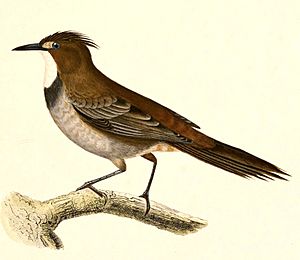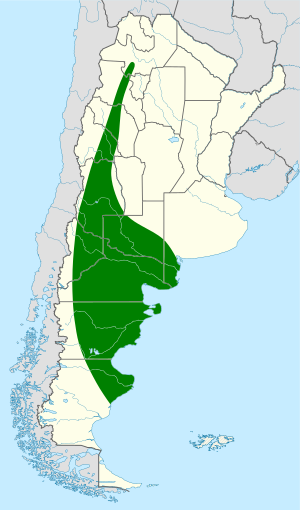White-throated cacholote facts for kids
Quick facts for kids White-throated cachalote |
|
|---|---|
 |
|
| Conservation status | |
| Scientific classification | |
| Genus: |
Pseudoseisura
|
| Species: |
gutturalis
|
 |
|
The white-throated cacholote (Pseudoseisura gutturalis) is a special type of bird. It belongs to the Furnariidae family, which are often called "ovenbirds" because some of them build nests that look like old-fashioned ovens.
This bird lives in Argentina. You can find it in the southern region called Patagonia and also in the northwest parts of the country. Its natural home is in places with subtropical or tropical dry shrubland. This means it likes warm areas with lots of bushes and small trees.
Contents
Meet the White-throated Cacholote
The white-throated cacholote is a unique bird. It gets its name from the white feathers on its throat. It is part of a group of birds known for their interesting calls and how they build their homes.
What Does It Look Like?
This bird is usually a medium-sized bird. It has a mix of brown and reddish-brown feathers. The most noticeable part is its white throat, which makes it easy to identify. Its beak is strong, perfect for finding food.
Where Does It Live?
The white-throated cacholote prefers dry, bushy areas. These places are often found in warmer climates. In Argentina, it lives in two main areas:
- Patagonia: This is a large, wild region in the south. It has dry plains and scrublands.
- Northwest Argentina: This area also has dry habitats suitable for the bird.
Its home, the dry shrubland, has many bushes and small trees. These provide good places for the bird to find food and build its nest.
What Does It Eat?
Like many birds, the white-throated cacholote likely eats insects and other small creatures. It might also eat seeds or fruits found in its shrubland habitat. Its strong beak helps it to search for food in the ground or among the plants.
Life Cycle and Reproduction
Birds like the cacholote usually build nests to lay their eggs. The parents then take turns sitting on the eggs to keep them warm. After the chicks hatch, both parents work together to feed them. They teach the young birds how to find food and survive on their own.
The cacholote's nest is often well-hidden in the dense shrubs. This helps to protect the eggs and young birds from predators.
Conservation Status
The white-throated cacholote is currently listed as "Least Concern" (LC) by the IUCN. This means that its population is stable. It is not considered to be in danger of disappearing right now. However, it is always important to protect their natural homes. This helps to make sure these birds can continue to thrive.
See also
 In Spanish: Cacholote pardo para niños
In Spanish: Cacholote pardo para niños


